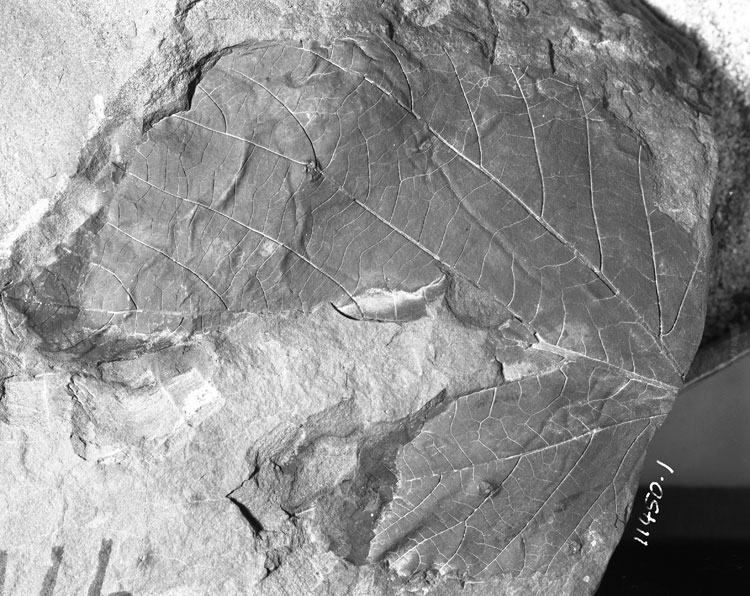Locality
Arctic Slope of Alaska locality USGS 11606, north of Maybe Creek. This locality is a bluff approximately 10 m high on the east side of an unnamed tributary of the Price River. The predominant lithologies are bentonitic clays overlying a silty sandstone capped by coal beds up to 2 m thick, which are in turn overlain by a white-gray medium-grained sandstone. Irregularly dispersed throughout the clay are nodules and sheets of ferruginous limestone (sideritic) which, although light gray when fresh, weather to a rusty brown. With the exception of some poorly preserved plant matter in the upper sandstones, and impressions of platanoid leaves in the power sandtsones, the plant material is confined to these fine-grained iron-rich nodules and is preserved as impressions totally lacking cuticle. There is little evidence of post-mortem decay but many leaves are penetrated by vertical fossil rootlets. Platanoid leaves are most common in siltier/sandier facies. The uppermost coal surface supports several in situ tree bases each of which is approximately 20 cm in diameter.
Latitude: 69.528329 °N
Longitude: -153.887128 °W
Description
Leaf: simple; symmetrical (?); wide elliptic; apex acute; base missing; margin serrate, apical angle of tooth variable but most acute, rounded sinuses, teeth more or less uniform in size and spacing; venation perfect marginal actinodromous; midvein moderate in thickness, possibly curved and slightly sinuous near the apex; pectinal veins arising at an angle of 30° from the midvein, moderate slightly curved; superior secondary veins moderate diverging from the primary midvein at an angle of approximately 30° at the leaf base becoming more obtuse near the apex, more or less straight but often curved towards the apex close to the point of origin on the midvein, branched sometimes 1 or 2 times abmedially near the margin; pectinal abmedials arising at angles of approximately 30° straight or slightly curved and forked at least once near the margin, the basal abmedial giving off a vein of approximately the same thickness as itself close to the origin on the pectinal at an angle of approximately 30°; tertiary veins mostly forming acute angles, with both admedial and abmedial sides of secondaries, tending to join at right angles near the margin, percurrent, usually simple but often forked, convex, relationship to midvein oblique remaining more or less constant except the tertiaries between the pectinal abmedials which are at a greater angle than the tertiaries in the rest of the leaf, arrangement alternate and opposite in about equal proportions; fourth order veins distinct orthogonal, percurrent straight or sinuous sometimes forked arising at approximately 90° from the tertiaries.
Remarks
There is some asymmetry to this leaf which may or may not have a biological origin. While the venation is well preserved the details of the teeth are obscure in that the termination of the tooth medial vein is unclear. The medial vein is accompanied by higher order laterals forming a series of brochidodromous loops as is typical of 'Platanoid' teeth but the swollen glandular apex is missing. There can be little doubt, however, that on the basis of its architectural characteristics, this leaf displays hamamelid characters. The presence of a vein of the same thickness as the basal pectinal abmedial arising from it close to the junction with the pectinal could well be interpreted as 'incipient', or poorly developed, palinactinodromy.
This specimen is apparently identical to those described by Bell (1963) under the name 'Platanus' williamsi from the Dunvegan Formation, British Columbia, which is of Cenomanian age.
